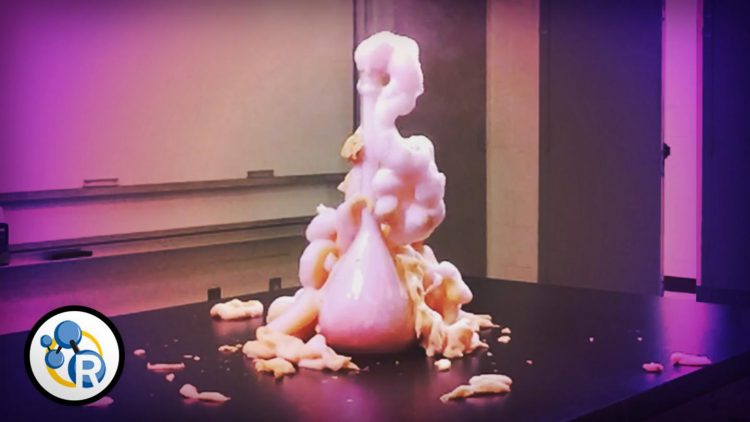Foam explosion in super slow motion (video)

You might have seen this wacky experiment in a chemistry class or on late-night TV. Dropping a mixture into some hydrogen peroxide produces a huge foamy flume. But what's actually causing that big mess? Turns out it's a great illustration of a key concept in chemistry. In this week's video, Reactions teams up with chemistry professor Matt Hartings, Ph.D., to explain the Elephant Toothpaste experiment. Check it out here: https://youtu.be/PX7TIqAJRSY. Credit: The American Chemical Society
Dropping a mixture into some hydrogen peroxide produces a huge foamy flume. But what's actually causing that big mess?
Turns out it's a great illustration of a key concept in chemistry.
In this week's video, Reactions teams up with chemistry professor Matt Hartings, Ph.D., to explain the Elephant Toothpaste experiment.
Check it out here: https:/
###
Subscribe to the series at http://bit.
The American Chemical Society is a nonprofit organization chartered by the U.S. Congress. With more than 158,000 members, ACS is the world's largest scientific society and a global leader in providing access to chemistry-related research through its multiple databases, peer-reviewed journals and scientific conferences. Its main offices are in Washington, D.C., and Columbus, Ohio.
To automatically receive news releases from the American Chemical Society, contact newsroom@acs.org.
Media Contact
All latest news from the category: Life Sciences and Chemistry
Articles and reports from the Life Sciences and chemistry area deal with applied and basic research into modern biology, chemistry and human medicine.
Valuable information can be found on a range of life sciences fields including bacteriology, biochemistry, bionics, bioinformatics, biophysics, biotechnology, genetics, geobotany, human biology, marine biology, microbiology, molecular biology, cellular biology, zoology, bioinorganic chemistry, microchemistry and environmental chemistry.
Newest articles

Microscopic basis of a new form of quantum magnetism
Not all magnets are the same. When we think of magnetism, we often think of magnets that stick to a refrigerator’s door. For these types of magnets, the electronic interactions…

An epigenome editing toolkit to dissect the mechanisms of gene regulation
A study from the Hackett group at EMBL Rome led to the development of a powerful epigenetic editing technology, which unlocks the ability to precisely program chromatin modifications. Understanding how…

NASA selects UF mission to better track the Earth’s water and ice
NASA has selected a team of University of Florida aerospace engineers to pursue a groundbreaking $12 million mission aimed at improving the way we track changes in Earth’s structures, such…





















